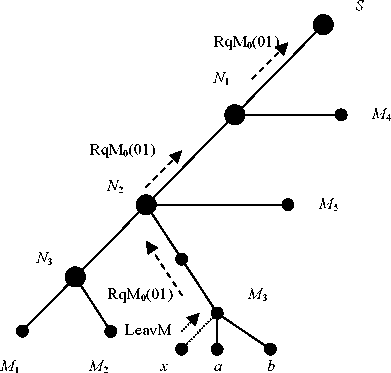■ Case 2: the leaving member is the last member connected to the designated LMR and
the BNR connecting this LMR will stay a BNR after member leaving the multicast
group.
■ Case 3 : the leaving member is the last member connected to the designated LMR and
the BNR connecting this LMR will not be a BNR any more.
In this section these cases will be discussed in detail assuming that S is the multicast group
source node, N1 to N3 are IMRs or BNRs, M1 to M5 are LMRs and (a, b) and (x) are
receivers already joined or need to leave the multicast tree respectively.
■ Case 1:
In this case, Figure 4.9, the leaving member (x) sends a leaveM message to its designated
LMR (M3), M3 will know that the leaving member (x) is not the last member connected to it.
This is done by checking the entries in the Multicast Destination Table (MDT) maintained
each LMR.

Figure 4.9 Leaving process in SReM (Case 1)
|
Nodes |
MFTs | |
|
Before x leaves |
After x leaves | |
|
S (Source) |
MTI | IP_V1 |
unchanged |
|
V1 |
MTI | IP_V3 &IP_M4 |
unchanged |
|
V2 |
MTI | IP_V3 , IP_M3, IP_M5 |
unchanged |
|
V3 |
MTI | IP_M1 & IP_M2 |
unchanged |
Leave message
RqM
The designated LMR (M3) will initiate a RqM0(01) message and forwards it directly to the
source. Because the S bit flag is 0, the intermediate IMRs or BNRs will not process this
message and it will take a short period of time to arrive the source. It worth noting that there
is no changing in the multicast tree because member (x) leaving the group.
70
More intriguing information
1. Determinants of U.S. Textile and Apparel Import Trade2. Initial Public Offerings and Venture Capital in Germany
3. Road pricing and (re)location decisions households
4. Consumer Networks and Firm Reputation: A First Experimental Investigation
5. AJAE Appendix: Willingness to Pay Versus Expected Consumption Value in Vickrey Auctions for New Experience Goods
6. The name is absent
7. Evolutionary Clustering in Indonesian Ethnic Textile Motifs
8. Opciones de política económica en el Perú 2011-2015
9. A Duality Approach to Testing the Economic Behaviour of Dairy-Marketing Co-operatives: The Case of Ireland
10. Pursuit of Competitive Advantages for Entrepreneurship: Development of Enterprise as a Learning Organization. International and Russian Experience